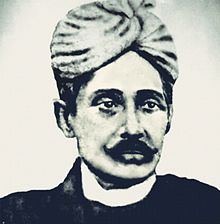When people speak of the history of tea in India there seems to be the feeling that you are about to hear some great epic story. Over the years I have heard snippets of tea’s history in India, but I decided to dig deeper and find out the full story of tea’s colorful history in India.
Tea and tea plantations as we know them today were first introduced to India by the British as a way to cut off China’s monopoly on the tea trade in the early 1800s. They felt it could be a way to strengthen their empire and also a great income source for England. However, the British did not introduce the actual tea plant to India; it had been growing in the wild in the jungles of Assam all along. Captain Charles Alexander Bruce is credited with the discovery of tea plants in Assam even though the Singhpo tribe had already been cultivating and brewing the young leaves of the plants for many generations. It is said that the British got the idea to prune down the tea bushes when Chief Bisa Guam’s army slashed the tea bushes in protest of the British royalty imposing on their lands. To this day, in the Tinsukia district of Assam the Singhpo people still practice the traditions of cultivating tea in their home gardens. Tea is an indigenous plant of Assam and grew well all on its own; but the British still felt the tea bushes in China were far superior and decided to bring seeds into India that were considered to be of the best growing stock from Chinese tea gardens.

On February 12, 1839 the first tea company ever in India, The Assam Company, was set up through a deed of British Parliament. At the same time, another company called the Bengal Tea Association was formed in Calcutta. It took much hard work and follow through after initial setbacks, but eventually The Assam Company did so well that Queen Victoria directed members of her court to favor Assam tea over that from China. In 1845, The Assam Company was fully incorporated by the Parliament and the original company seal read, ingenious et labore which means ingenuity and hard work. After their success, the British decided that all tea grown in Assam would come from the native plants and this new British-Indian tea variety began to flourish.
Early tea garden cultivation wasn’t for the faint of heart. Pioneer tea planters hacked their way through the jungles to burn and slash out tracts of land persevering through the harsh climate while fighting off constant threats from jungle predators as well as illnesses, such as malaria and cholera. Just to get out to the tea gardens could take up to three months of travel time by both a slow boat up the river then via elephant caravans through tiger infested jungles. However, none of these things discouraged investors and soon innovations were made to cut travel time steeply down. Steamboats were commissioned for travel up and down the rivers which was quickly followed by the development of the railway system in the Assam region.

An Indian national, Maniram Butta Barua, known as the Martyr of Indian Tea, worked as a dewan (land agent) for the Assam Company but resigned in 1845 to set up his own tea plantation. The British colonialists couldn’t stand for there to be any competition in the tea market from national entrepreneurs; so, in 1858 he was arrested in Calcutta and hanged as a warning to other nationals against entering the tea market.
As tea production increased and became more successful in Assam, the British looked to other areas of India to cultivate tea. In 1839, Dr. Campbell, a civil surgeon, who was appointed Superintendent of Darjeeling District decided to plant tea near his home in an effort to attract other settlers to the area. Darjeeling District proved to be quite fertile ground for growing tea and after about a decade there were over a hundred tea gardens growing both black and green tea varieties in that district. The British then set their eyes towards the northwestern foothills of the Himalayan mountains where they had some success in growing varietals of Chinese tea in smaller quantities than what was being produced in Assam and Darjeeling districts. Tea came to southern India around the same time as it did to the Darjeeling district. A French botanist named M.Perrottet planted the first seedlings around Ooty in the Nilgris. The British realized that tea could be grown in the geographic region from the Western Ghats to the Arabian Sea and set to work establishing gardens throughout the region. The first Nilgiri tea was manufactured in 1854 on a tea estate in Coonoor and by 1926 tea gardens had reached the southernmost point of the hilly Ghats.

Even after the tragic death of Maniram Dutta Barua, there were still a few brave Indians who worked to establish their own private tea estates. In the late 1800s, Marwari families from the western states of Rajasthan and Marwar also migrated to Assam and Bengal to learn the tea trade and eventually began buying up tea businesses in the early 1900s. Beginning in the late 1800s, tea businesses were managed through Managing Agency houses in Calcutta with overseas holdings in England and Scotland, but after India’s independence national entrepreneurs, many of them Marwari, began buying up the overseas holdings as well as the Indian equity in each of the companies. The majority of Indian chai (tea) was finally being cultivated, produced, and sold by Indian nationals.
